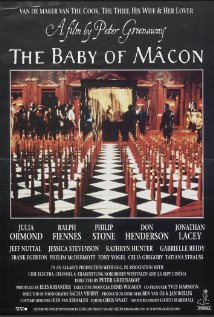
THE BABY OF MACON.
UK, 1993, 133 minutes, Colour.
Julia Ormonde, Reith finds, Philip Capstone.
Directed by Peter Greenaway.
A Peter Greenaway film is not to everyone’s taste. Perhaps he was born in the wrong century. He seems so at home in the past, its looks, its style, its issues. He belongs to a more earthy and graphic culture than our own (at least in what is usually represented in art forms) so that even allegedly robust audiences find him too much. This will be the case with The Baby of Macon.
However, for those who are able to sit through it (and the blood may be too much for some, as may the cruelly vengeful execution of the woman), there is much to observe, much to appreciate and, as regards religion, much to think about. A useful parallel would be Ken Russell’s films, especially The Devils, although Greenaway is far more disciplined in excess.
Set in 17th century France, and looking sumptuous and sounding exquisite, this morality play, performed in a cathedral, dramatises the use and misuse of religion and church authority, superstition and false miracles and relics and their consequent gross environments.
This is an intelligent and demanding film that requires attentiveness and thought rather than a quick look and superficial dismissal. It is archetypal Greenaway.
1. The impact of the film? Pageant, history, civil authorities, ecclesiastical authorities? Sexuality, birth, rape? The desire for miracles and excesses for relics?
2. The career of Peter Greenaway, his interests, style, art, photography, dialogue?
3. A play of the 17th century, with actors, as characters, as themselves? Providing some distance for the audience as well as involvement?
4. The division of the film into various acts, theatrical?
5. The situation, the palace, the benches, the rooms, the audience, ordinary people, costumes and decor, the ecclesiastics? Civil authorities? Watching the birth, responding with counting the number of contractions? The consequences?
6. The title, the baby as a saviour-figure, echoes of the Virgin Mary’s conception? The monstrous mother, the midwives, the suffering of birth, action? Audience curiosity and participation?
7. The clergy, the hierarchy, in vestments? As real clerics, as actors allegedly portraying clerics? The Dean of the cathedral his son?
8. The prologue, the strange character, speaking, stuttering, and his appearance at the end, providing a frame?
9. The commentary, the confessor, the behaviour of the clerics and supervising? The aristocracy, the old and the young, observing?
10. The emergence of the young woman, as an actress, as mother, loving the baby, caring for it, protecting it?
11. Servants, soldiers, the contribution? The actors looking for casting roles and being employed?
12. The benefits the draw, his character, his concern about his son, about the church? The son, his character, observing, his encounter with the woman, sexual, graphic, nudity, the attack on him, the blood?
13. The Dean, his reaction, wanting vengeance?
14. The authorities and condemnation of the woman, taken, on the bed, her defiance, victim? Her continually protesting virginity? The rapists and their affirming it?
15. The men, getting ready, the queue, vicious, environment, the huge number?
16. The child, the role, the symbol? Death, no miracles, the crowds wanting the relics and tearing from limb to limb?
17. The critique of the contemporary society, of the church? As applicable to the present day?
18. An all-out morality play?